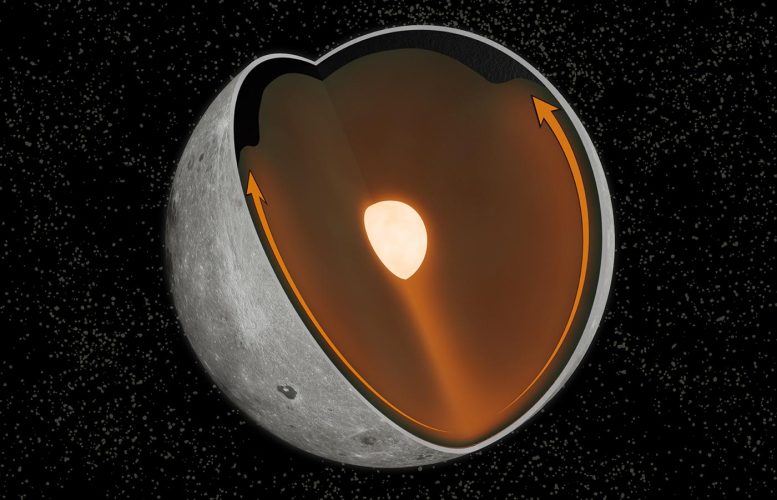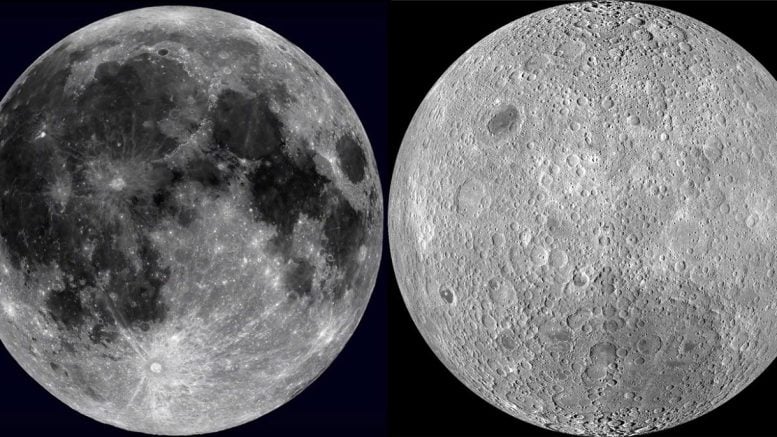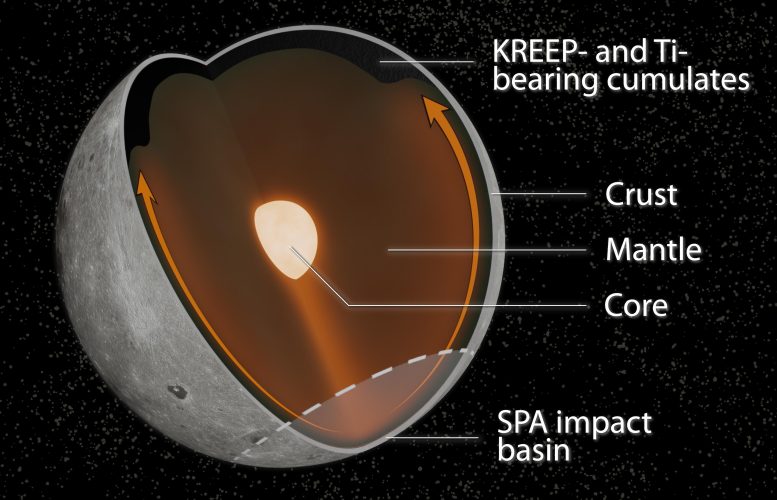
Um novo estudo mostra que uma antiga colisão no pólo sul da lua alterou os padrões de convecção no manto lunar, concentrando vários elementos produtores de calor no lado próximo. Esses elementos desempenharam um papel na formação da égua gigante da lua visível da Terra. Crédito da foto: Matt Jones
Novas pesquisas mostram como o impacto que criou a bacia de Aitken do pólo sul da lua está relacionado ao forte contraste na composição e aparência entre os dois lados da lua.
A face que a lua mostra para a terra parece muito diferente do que ela esconde do outro lado. The Aside é dominado pela Lunar Mare – os vastos remanescentes em tons escuros de antigos fluxos de lava. O outro lado da cratera, por outro lado, é praticamente desprovido de grandes características de mar. Por que os dois lados são tão diferentes é um dos mistérios mais duradouros da lua.
Agora, os pesquisadores têm uma nova explicação para a lua de duas faces – uma que se relaciona com um impacto gigante há bilhões de anos perto do pólo sul da lua.
Um novo estudo publicado na revista Science Advances mostra que o impacto que formou a vasta Bacia do Pólo Sul-Aitken (SPA) da lua teria criado uma enorme pluma térmica que se espalhou pelo interior da lua. Essa nuvem teria carregado certos materiais – uma série de terras raras e elementos geradores de calor – para o lado mais próximo da lua. Essa concentração de elementos teria contribuído para o vulcanismo que criou as planícies vulcânicas próximas.

A frente da lua (à esquerda) é dominada por vastos depósitos vulcânicos, enquanto o lado mais distante (à direita) tem muito menos dela. Por que os dois lados são tão diferentes é um mistério lunar contínuo. Crédito da foto: Brown University
“Sabemos que grandes impactos como o que formou o SPA gerariam muito calor”, disse Matt Jones, Ph.D. Candidato à Brown University e principal autor do estudo. “A questão é como esse calor afeta a dinâmica interna da lua. O que mostramos é que sob todas as condições plausíveis no momento em que o SPA é formado, esses elementos geradores de calor se concentram no lado próximo. Acreditamos que isso contribuiu para o derretimento do manto que produziu os fluxos de lava que vemos na superfície”.
O estudo foi uma colaboração entre Jones e seu orientador, Alexander Evans, professor assistente da Brown University, juntamente com pesquisadores da Purdue University, do Laboratório de Ciências Lunares e Planetárias do Arizona, da Universidade de Stanford e[{” attribute=””>NASA’s Jet Propulsion Laboratory.

A new study reveals that an ancient collision on the Moon’s south pole changed patterns of convection in the lunar mantle, concentrating a suite of heat-producing elements on the nearside. Those elements played a role in creating the vast lunar mare visible from Earth. Credit: Matt Jones
The differences between the near and far sides of the Moon were first revealed in the 1960s by the Soviet Luna missions and the U.S. Apollo program. While the differences in volcanic deposits are plain to see, future missions would reveal differences in the geochemical composition as well. The nearside is home to a compositional anomaly known as the Procellarum KREEP terrane (PKT) — a concentration of potassium (K), rare earth elements (REE), phosphorus (P), along with heat-producing elements like thorium. KREEP seems to be concentrated in and around Oceanus Procellarum, the largest of the nearside volcanic plains, but is sparse elsewhere on the Moon.
Some scientists have suspected a connection between the PKT and the nearside lava flows, but the question of why that suite of elements was concentrated on the nearside remained. This new study provides an explanation that is connected to the South Pole–Aitken basin, the second largest known impact crater in the solar system.
For the study, the researchers conducted computer simulations of how heat generated by a giant impact would alter patterns of convection in the Moon’s interior, and how that might redistribute KREEP material in the lunar mantle. KREEP is thought to represent the last part of the mantle to solidify after the Moon’s formation. As such, it likely formed the outermost layer of mantle, just beneath the lunar crust. Models of the lunar interior suggest that it should have been more or less evenly distributed beneath the surface. But this new model shows that the uniform distribution would be disrupted by the heat plume from the SPA impact.
According to the model, the KREEP material would have ridden the wave of heat emanating from the SPA impact zone like a surfer. As the heat plume spread beneath the Moon’s crust, that material was eventually delivered en masse to the nearside. The team ran simulations for a number of different impact scenarios, from dead-on hit to a glancing blow. While each produced differing heat patterns and mobilized KREEP to varying degrees, all created KREEP concentrations on the nearside, consistent with the PKT anomaly.
The researchers say the work provides a credible explanation for one of the Moon’s most enduring mysteries.
“How the PKT formed is arguably the most significant open question in lunar science,” Jones said. “And the South Pole–Aitken impact is one of the most significant events in lunar history. This work brings those two things together, and I think our results are really exciting.”
Refernece: “A South Pole–Aitken impact origin of the lunar compositional asymmetry” by Matt J. Jones, Alexander J. Evans, Brandon C. Johnson, Matthew B. Weller, Jeffrey C. Andrews-Hanna, Sonia M. Tikoo and James T. Kean, 8 April 2022, Science Advances.
DOI: 10.1126/sciadv.abm8475

“Passionate student. Twitter nerd. Avid bacon addict. Typical troublemaker. Thinker. Webaholic. Entrepreneur.”









